Prevention of Nosocomial Infections: Evidence-Based Practice Report
VerifiedAdded on 2022/09/14
|6
|776
|17
Report
AI Summary
This report focuses on the prevention of nosocomial infections within a healthcare setting. The author, working in a hospital in Boston, identifies a significant gap in infection control, highlighting risks to patients due to factors such as patient volume, medical procedures, and inadequate sterilization. The ...

E V I D E N C E B A S E D
P R A C T I C E
P R A C T I C E
Paraphrase This Document
Need a fresh take? Get an instant paraphrase of this document with our AI Paraphraser
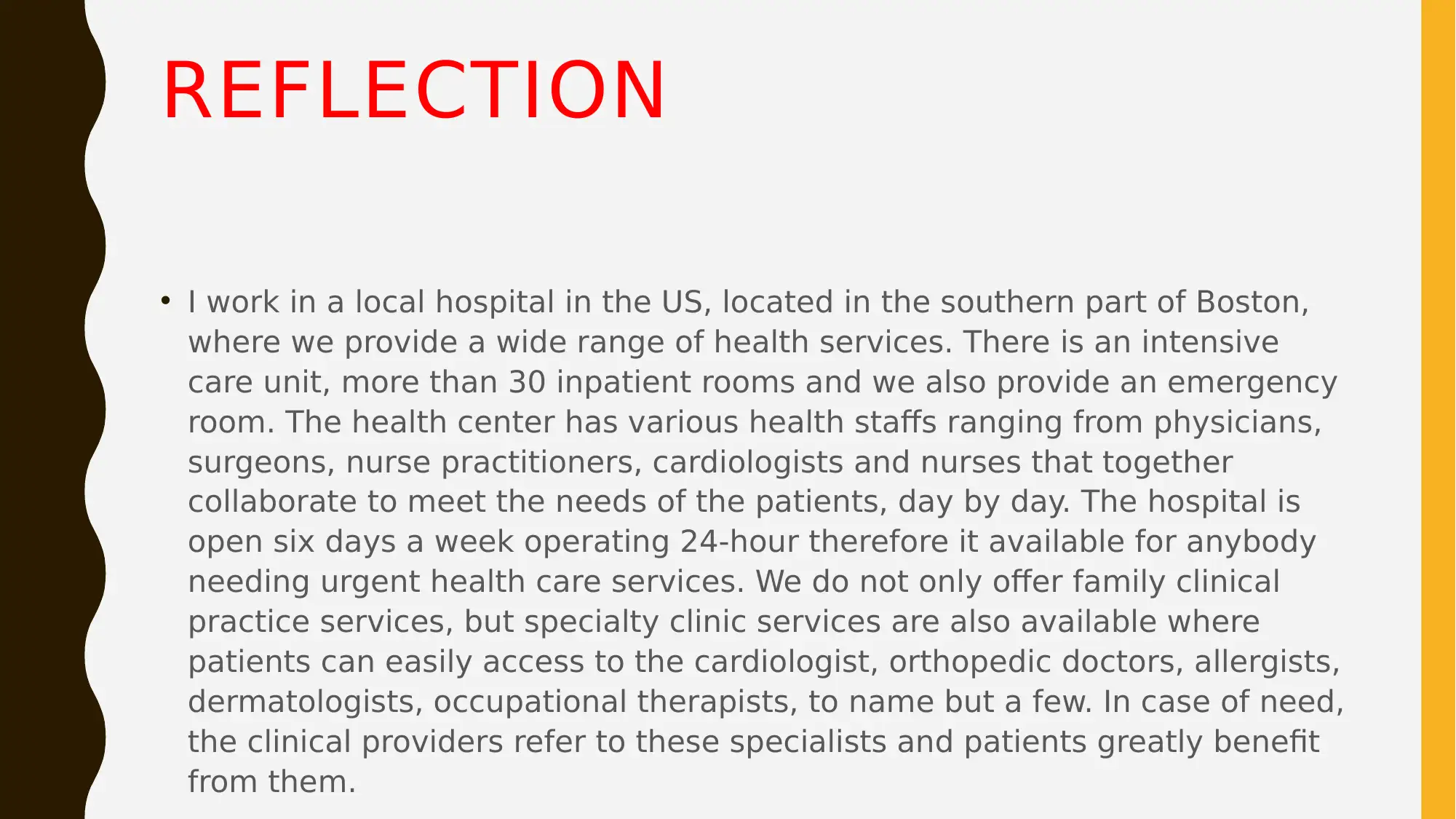
REFLECTION
• I work in a local hospital in the US, located in the southern part of Boston,
where we provide a wide range of health services. There is an intensive
care unit, more than 30 inpatient rooms and we also provide an emergency
room. The health center has various health staffs ranging from physicians,
surgeons, nurse practitioners, cardiologists and nurses that together
collaborate to meet the needs of the patients, day by day. The hospital is
open six days a week operating 24-hour therefore it available for anybody
needing urgent health care services. We do not only offer family clinical
practice services, but specialty clinic services are also available where
patients can easily access to the cardiologist, orthopedic doctors, allergists,
dermatologists, occupational therapists, to name but a few. In case of need,
the clinical providers refer to these specialists and patients greatly benefit
from them.
• I work in a local hospital in the US, located in the southern part of Boston,
where we provide a wide range of health services. There is an intensive
care unit, more than 30 inpatient rooms and we also provide an emergency
room. The health center has various health staffs ranging from physicians,
surgeons, nurse practitioners, cardiologists and nurses that together
collaborate to meet the needs of the patients, day by day. The hospital is
open six days a week operating 24-hour therefore it available for anybody
needing urgent health care services. We do not only offer family clinical
practice services, but specialty clinic services are also available where
patients can easily access to the cardiologist, orthopedic doctors, allergists,
dermatologists, occupational therapists, to name but a few. In case of need,
the clinical providers refer to these specialists and patients greatly benefit
from them.
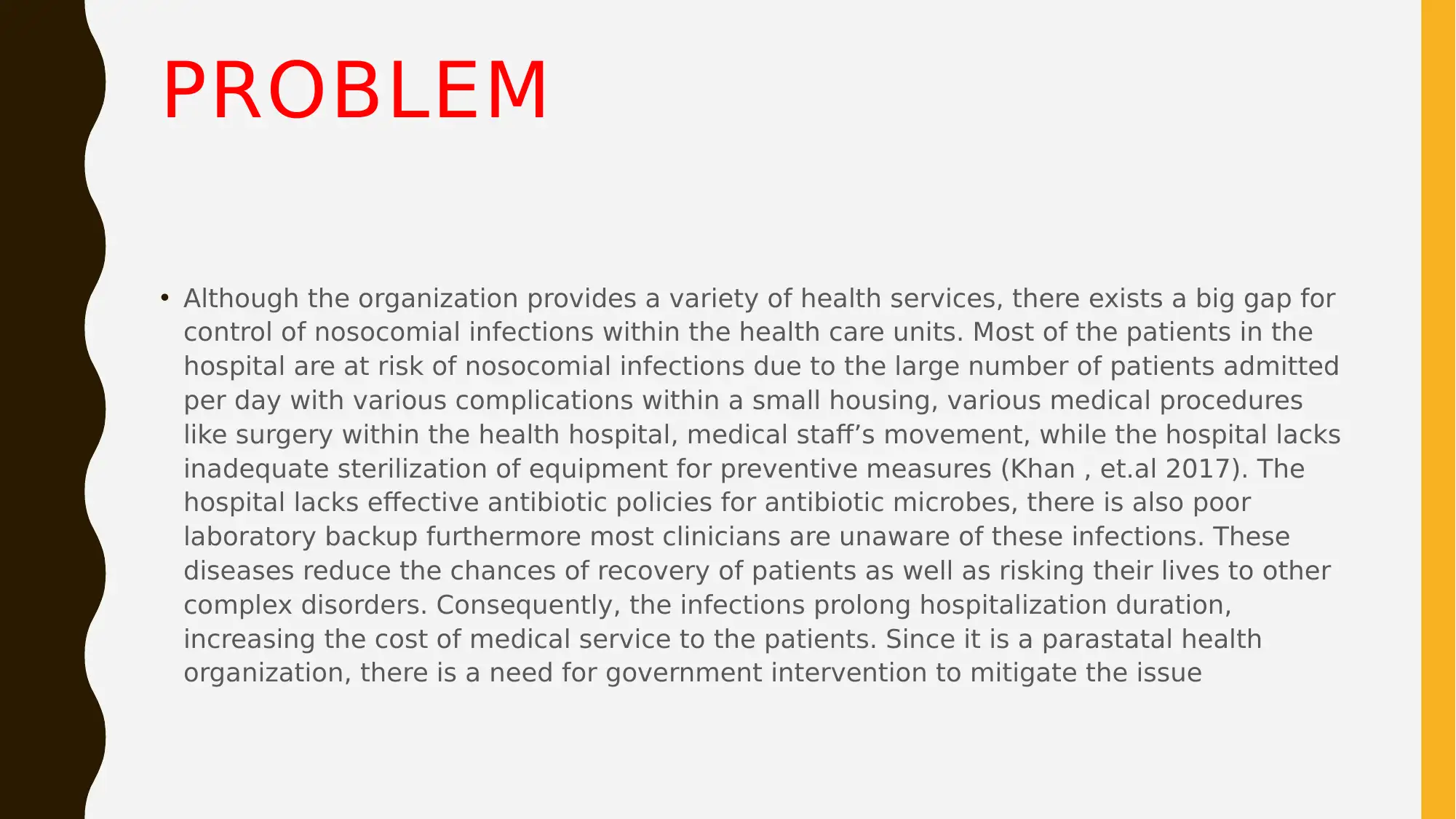
PROBLEM
• Although the organization provides a variety of health services, there exists a big gap for
control of nosocomial infections within the health care units. Most of the patients in the
hospital are at risk of nosocomial infections due to the large number of patients admitted
per day with various complications within a small housing, various medical procedures
like surgery within the health hospital, medical staff’s movement, while the hospital lacks
inadequate sterilization of equipment for preventive measures (Khan , et.al 2017). The
hospital lacks effective antibiotic policies for antibiotic microbes, there is also poor
laboratory backup furthermore most clinicians are unaware of these infections. These
diseases reduce the chances of recovery of patients as well as risking their lives to other
complex disorders. Consequently, the infections prolong hospitalization duration,
increasing the cost of medical service to the patients. Since it is a parastatal health
organization, there is a need for government intervention to mitigate the issue
• Although the organization provides a variety of health services, there exists a big gap for
control of nosocomial infections within the health care units. Most of the patients in the
hospital are at risk of nosocomial infections due to the large number of patients admitted
per day with various complications within a small housing, various medical procedures
like surgery within the health hospital, medical staff’s movement, while the hospital lacks
inadequate sterilization of equipment for preventive measures (Khan , et.al 2017). The
hospital lacks effective antibiotic policies for antibiotic microbes, there is also poor
laboratory backup furthermore most clinicians are unaware of these infections. These
diseases reduce the chances of recovery of patients as well as risking their lives to other
complex disorders. Consequently, the infections prolong hospitalization duration,
increasing the cost of medical service to the patients. Since it is a parastatal health
organization, there is a need for government intervention to mitigate the issue
⊘ This is a preview!⊘
Do you want full access?
Subscribe today to unlock all pages.

Trusted by 1+ million students worldwide
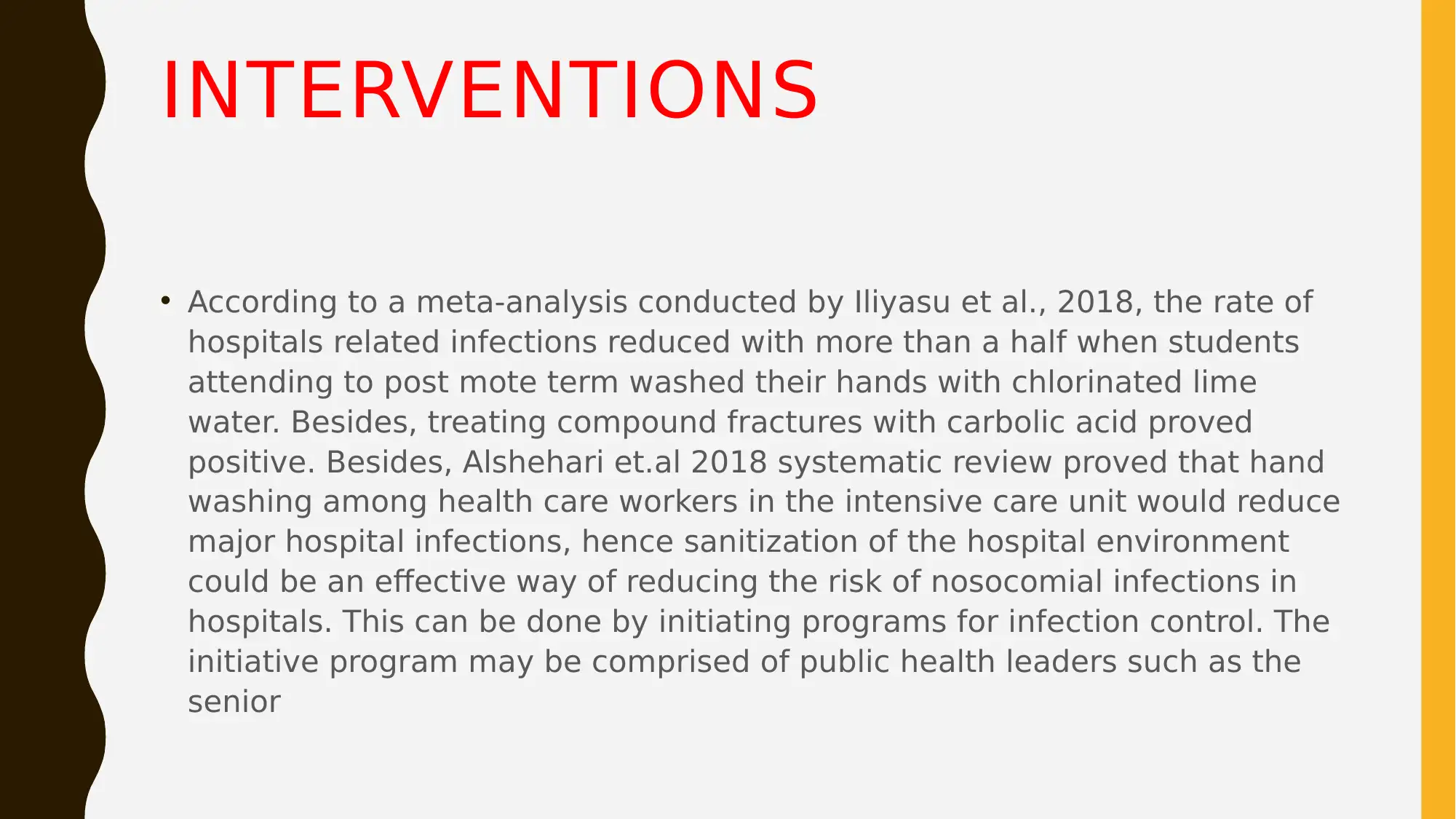
INTERVENTIONS
• According to a meta-analysis conducted by Iliyasu et al., 2018, the rate of
hospitals related infections reduced with more than a half when students
attending to post mote term washed their hands with chlorinated lime
water. Besides, treating compound fractures with carbolic acid proved
positive. Besides, Alshehari et.al 2018 systematic review proved that hand
washing among health care workers in the intensive care unit would reduce
major hospital infections, hence sanitization of the hospital environment
could be an effective way of reducing the risk of nosocomial infections in
hospitals. This can be done by initiating programs for infection control. The
initiative program may be comprised of public health leaders such as the
senior
• According to a meta-analysis conducted by Iliyasu et al., 2018, the rate of
hospitals related infections reduced with more than a half when students
attending to post mote term washed their hands with chlorinated lime
water. Besides, treating compound fractures with carbolic acid proved
positive. Besides, Alshehari et.al 2018 systematic review proved that hand
washing among health care workers in the intensive care unit would reduce
major hospital infections, hence sanitization of the hospital environment
could be an effective way of reducing the risk of nosocomial infections in
hospitals. This can be done by initiating programs for infection control. The
initiative program may be comprised of public health leaders such as the
senior
Paraphrase This Document
Need a fresh take? Get an instant paraphrase of this document with our AI Paraphraser
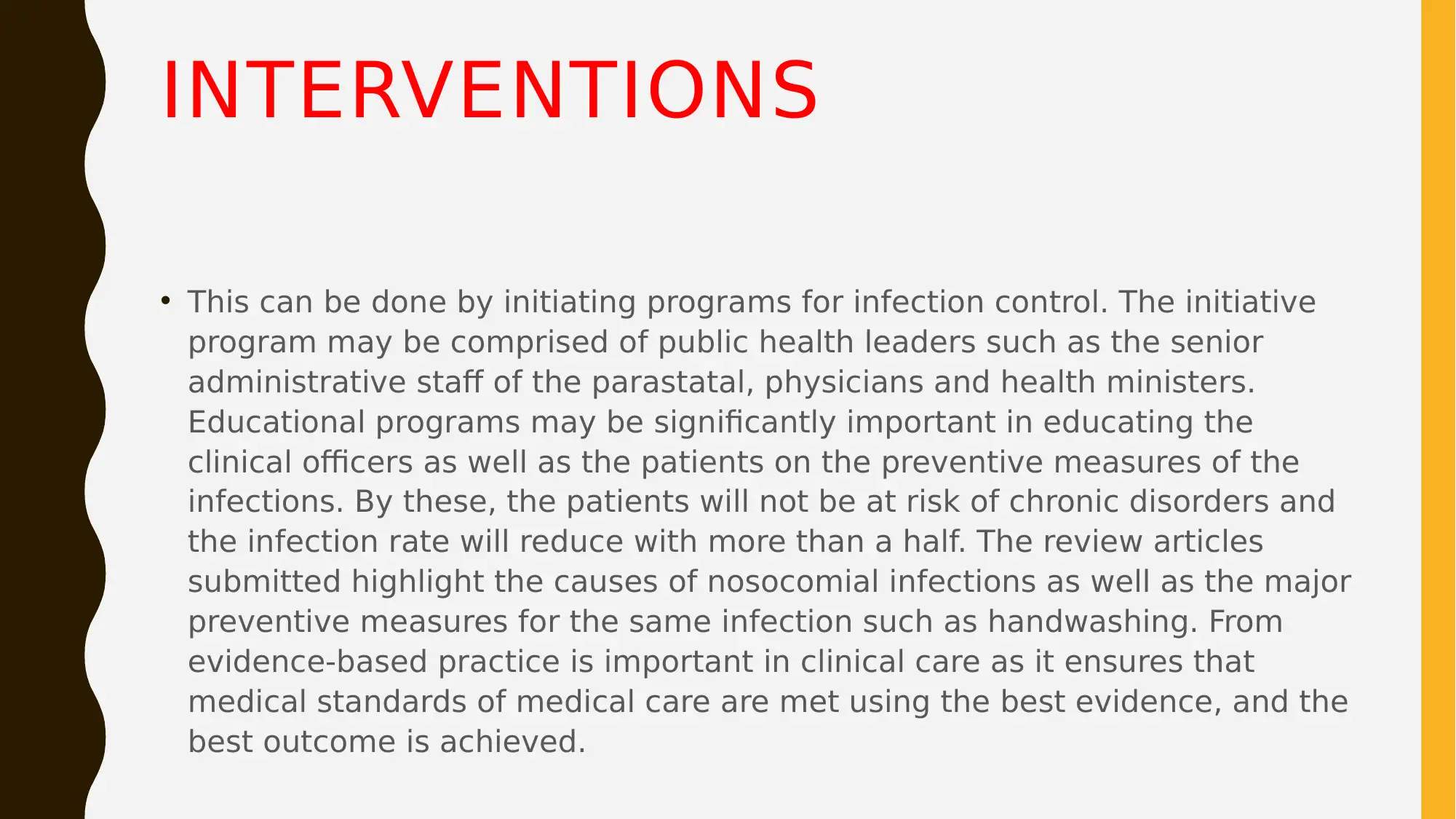
INTERVENTIONS
• This can be done by initiating programs for infection control. The initiative
program may be comprised of public health leaders such as the senior
administrative staff of the parastatal, physicians and health ministers.
Educational programs may be significantly important in educating the
clinical officers as well as the patients on the preventive measures of the
infections. By these, the patients will not be at risk of chronic disorders and
the infection rate will reduce with more than a half. The review articles
submitted highlight the causes of nosocomial infections as well as the major
preventive measures for the same infection such as handwashing. From
evidence-based practice is important in clinical care as it ensures that
medical standards of medical care are met using the best evidence, and the
best outcome is achieved.
• This can be done by initiating programs for infection control. The initiative
program may be comprised of public health leaders such as the senior
administrative staff of the parastatal, physicians and health ministers.
Educational programs may be significantly important in educating the
clinical officers as well as the patients on the preventive measures of the
infections. By these, the patients will not be at risk of chronic disorders and
the infection rate will reduce with more than a half. The review articles
submitted highlight the causes of nosocomial infections as well as the major
preventive measures for the same infection such as handwashing. From
evidence-based practice is important in clinical care as it ensures that
medical standards of medical care are met using the best evidence, and the
best outcome is achieved.
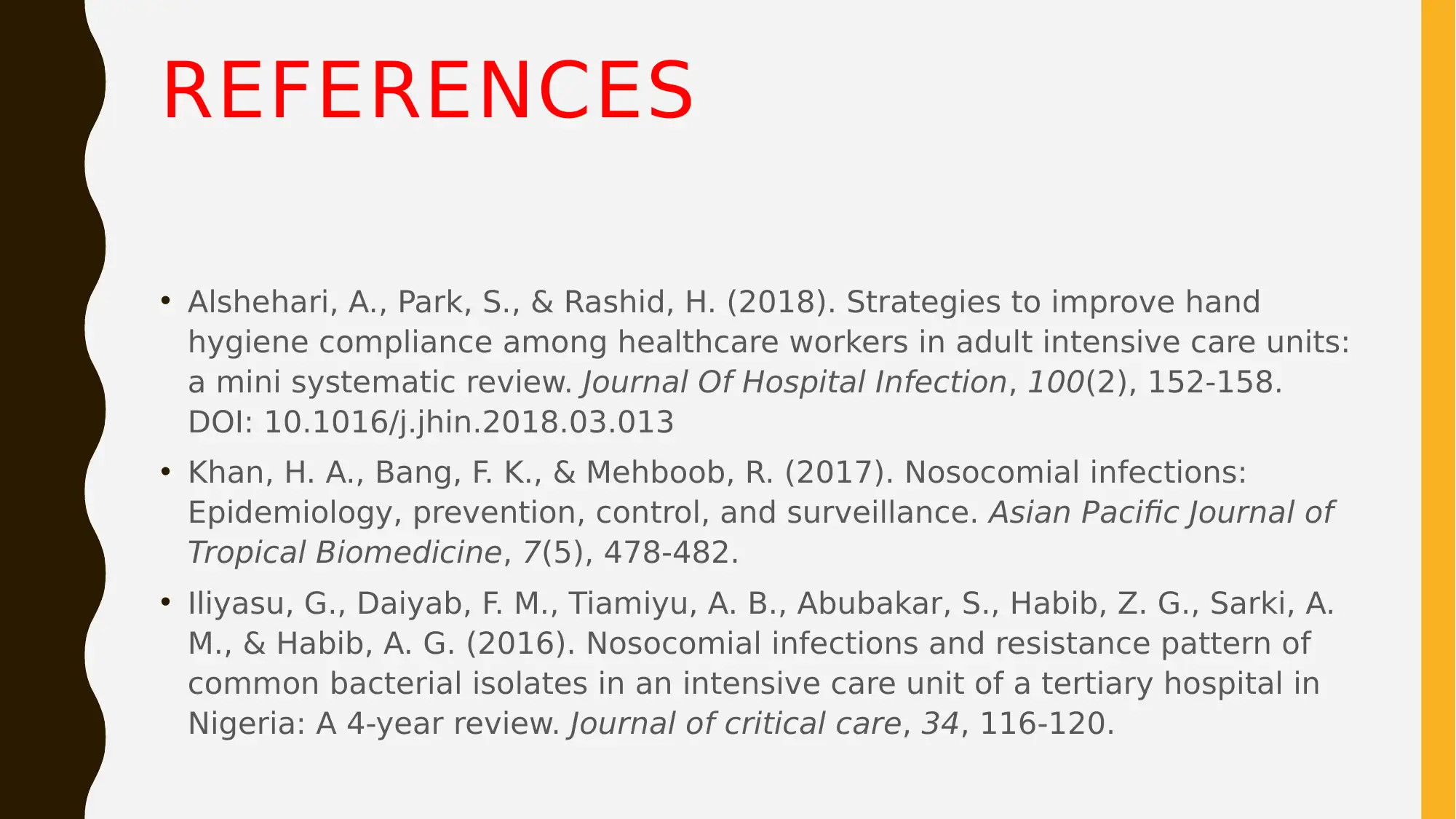
REFERENCES
• Alshehari, A., Park, S., & Rashid, H. (2018). Strategies to improve hand
hygiene compliance among healthcare workers in adult intensive care units:
a mini systematic review. Journal Of Hospital Infection, 100(2), 152-158.
DOI: 10.1016/j.jhin.2018.03.013
• Khan, H. A., Bang, F. K., & Mehboob, R. (2017). Nosocomial infections:
Epidemiology, prevention, control, and surveillance. Asian Pacific Journal of
Tropical Biomedicine, 7(5), 478-482.
• Iliyasu, G., Daiyab, F. M., Tiamiyu, A. B., Abubakar, S., Habib, Z. G., Sarki, A.
M., & Habib, A. G. (2016). Nosocomial infections and resistance pattern of
common bacterial isolates in an intensive care unit of a tertiary hospital in
Nigeria: A 4-year review. Journal of critical care, 34, 116-120.
• Alshehari, A., Park, S., & Rashid, H. (2018). Strategies to improve hand
hygiene compliance among healthcare workers in adult intensive care units:
a mini systematic review. Journal Of Hospital Infection, 100(2), 152-158.
DOI: 10.1016/j.jhin.2018.03.013
• Khan, H. A., Bang, F. K., & Mehboob, R. (2017). Nosocomial infections:
Epidemiology, prevention, control, and surveillance. Asian Pacific Journal of
Tropical Biomedicine, 7(5), 478-482.
• Iliyasu, G., Daiyab, F. M., Tiamiyu, A. B., Abubakar, S., Habib, Z. G., Sarki, A.
M., & Habib, A. G. (2016). Nosocomial infections and resistance pattern of
common bacterial isolates in an intensive care unit of a tertiary hospital in
Nigeria: A 4-year review. Journal of critical care, 34, 116-120.
⊘ This is a preview!⊘
Do you want full access?
Subscribe today to unlock all pages.

Trusted by 1+ million students worldwide
1 out of 6
Related Documents
Your All-in-One AI-Powered Toolkit for Academic Success.
+13062052269
info@desklib.com
Available 24*7 on WhatsApp / Email
![[object Object]](/_next/static/media/star-bottom.7253800d.svg)
Unlock your academic potential
© 2024 | Zucol Services PVT LTD | All rights reserved.





